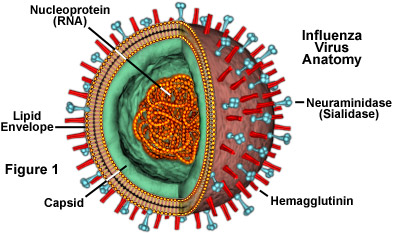|
Viruses isolated, Pauling publishes on the nature of the chemical bond.
|
"In 1947, the seasonal vaccine did not provide any protection against influenza"
"Jonas Salk attributed this finding to changes in the virus that had occurred since the previous year."
Ref: Zimmer et. al. 2009, "Historical Perspective — Emergence of Influenza A (H1N1) Viruses"
"The worldwide influenza epidemic of influenza in 1947 after the close of World War II has never fit neatly into either epidemic category. "
"It is generally accepted that epidemics of influenza A virus infection are of two distinct types: the first, which occur annually or biannually, are regional epidemics in partially immune populations, and the second, which occur at irregular and unpredictable intervals ranging from 11 to 30 years or more, confront essentially nonimmune populations and are global (pandemic) in distribution."
"he post-World War II epidemic of 1947 is notable for the total failure of a vaccine previously effective in the 1943–44 and 1944–45 seasons. We have combined extensive antigenic characterization of the hemagglutinin and neuraminidase antigens of the 1943 and 1947 viruses with analysis of their nucleotide and amino acid sequences and have found marked antigenic and amino acid differences in viruses of the two years. Furthermore, in a mouse model, vaccination with the 1943 vaccine had no effect on infection with the 1947 strain"
Ref:
Kilbourne 2002, "The total influenza vaccine failure of 1947 revisited: Major intrasubtypic antigenic change can explain failure of vaccine in a post-World War II epidemic."
|
Banner year for vitamin C.
|
H1N1 abruptly disappeared from humans in 1957
|
Swine influenza virus from a human occurred in 1974 from a patient with Hodgkin's disease who lived on a pig farm.
|
The debacle of the Swine Flu Fiasco: 1950 strain of H1N1 comes back.
H1N1 flu, not seen since 1950, reappears at Fort Dix, New NJ, USA. Mass vaccinations begin immediately but where canceled when the flu did not spread and concerned about side effects were raised.
32 deaths from this vaccine resulted.
1976: Abortive, Potentially Pandemic, Swine Influenza Virus Epidemic, Fort Dix, New Jersey (H1N1)
"In the interest of full disclosure, I predicted the possibility of an imminent pandemic in an op ed piece published in The New York Times on February 13, 1976 (25).
On February 13, I was notified that influenza viruses isolated from patients at Fort Dix, New Jersey, a few days earlier and provisionally identified as swine influenza viruses were being mailed to my laboratory in New York City. A high-yield (6:2) genetic reassortant virus (X-53) was produced and later used as a vaccine in a clinical trial in 3,000 people. An even higher yielding HA mutant virus, X-53a, was selected from X-53 and subsequently used in the mass vaccination of 43,000,000 people.
When no cases were found outside Fort Dix in subsequent months and the neurologic complication of Guillain-Barré syndrome occurred in association with administration of swine influenza vaccine, the National Immunization Program was abandoned, and the entire effort was assailed as a fiasco and disaster."
- Edwin D. Kilbourne
Influenza Pandemics of the 20th Century
https://www.ncbi.nlm.nih.gov/pmc/articles/PMC3291411/
|
The Russian virus was the one found in Fort Dix the year before.
The 1977 H1N1 Pandemic flu broke out in Russia and China and circled the globe.
"While it is possible that the 1977 influenza was caused by deliberate
release of the virus, the Soviet Bioweapons program, Biopreparat,
tended to use influenza preparedness as a cover story for
some of the more nefarious work that was being performed."[1]
"There is now a moratorium in the United States on funding GOF ("virus enhancement") research while the benefits and risks, including the potential for accident, are analyzed. Based on available evidence, the 1977 strain was indeed too closely matched to decades-old
strains to likely be a natural occurrence." - Rozo 2015
|
Swine influenza viruses possessing avian genes were first detected in Europe in 1979
|
An intraperitoneal dose of sodium ascorbate injected 10 min prior to morphine was found to provide significant protection against mortality
|
Quercetin exhibits antiviral activity only when protected against oxidative degradation by ascorbate
|
...these amounts directly provide the electrons necessary to quench the free radicals of almost any inflammation
|
(SIV), could have been present in any vaccine made from the tissues of these monkeys before 1985
|
...large-scale field trials of an experimental polio vaccine – trials that employed African ‘volunteers’ as guinea pigs
|
Production of infectious hepatitis C virus in tissue culture from a cloned viral genome
|
|
|
|
...genomic analysis of the recently resurrected 1918 virus...
|
"It is reported that about half of the humans who contract avian influenza in Vietnam do not die"
|
first recognized case of human disease from a swine influenza triple reassortant influenza A
|
H1N1 causes 100 deaths; 2155 cases of severe pneumonia, involving 821 hospitalizations
|
How Swine Flu Killed the Healthy
|
PA-X diminishes viral damage, PB1-F2 enhances morbidity and mortality.
At least two genes highly influence pathogenicity in influenza.
|
Public Health Office in Finnland study suggests recommending Vit C for colds
The common cold is not a single disease. Any one of up to 200 viruses including influenza can cause it.
Why some people get a "cold" from these viruses (some of which can be fatal) while others get more severe and sometimes fatal outcome from these same viruses has not been explained. It's along the same line of thinking that asks why some people don't get cancer or why a 50% fatal flu doesn't kill ot even infect the other half. What is it we're missing here?
|
Vitamin C supplementation improved endothelial function
|
The Reemergent 1977 H1N1 Strain and the Gain-of-Function Debate
|
"Penguins have US bird flu genes now"
|
Enhanced influenza disease in humans
|
Influenza vaccines seem to be modifying influenza into a dangerous dengue-like disease
|
The origins of the great pandemic
|
|
|

